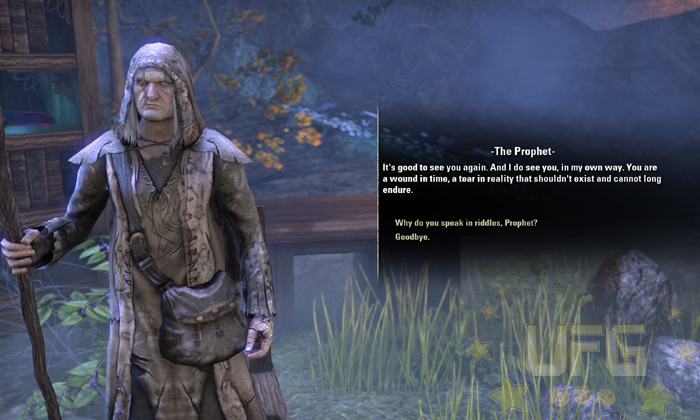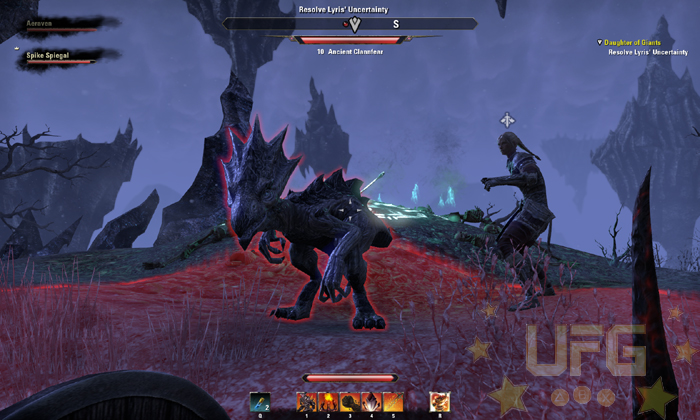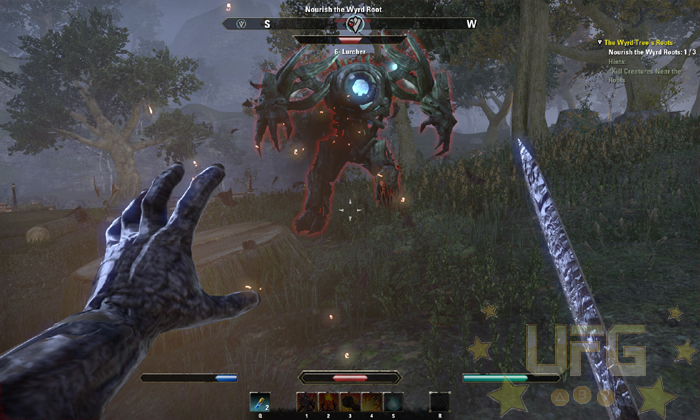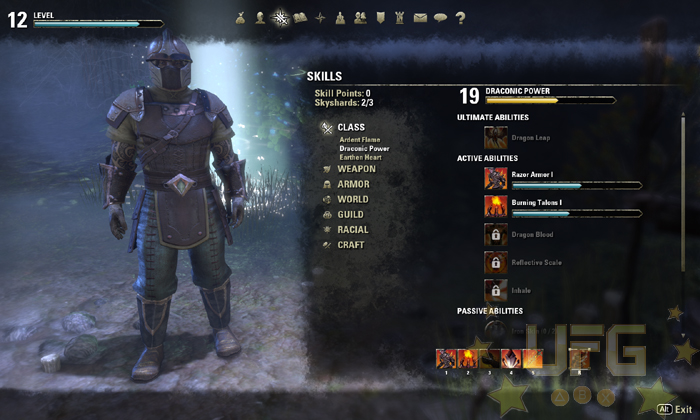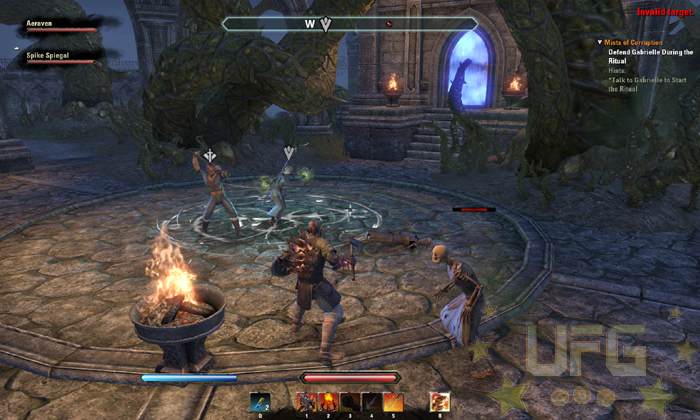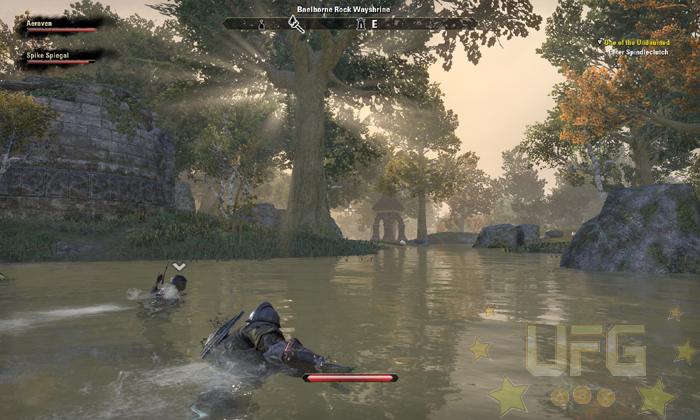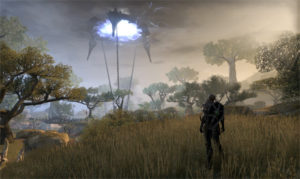UFG’s The Elder Scrolls Online Preview Part 1!
The Elder Scrolls series is wildly popular within the gaming industry. Its non-liner story progression, sprawling environments to explore, action based gameplay and an encyclopedia’s worth of lore have elevated it to classic status. The only thing that was missing over the years was a multiplayer option. Though the solo adventures were grand, gamers have been clamoring for the ability to explore this world with friends. Based on my experience with The Elder Scrolls Online, they may have finally gotten what they’ve been asking for!
The Elder Scrolls Online (TESO) is set in Tamriel, a continent on Nirn, 800 years before the events found in Elder Scrolls III and Oblivion. Molag Bal, the Daedric Prince of Domination, has set into motion a plan that will allow him to merge the plane of Oblivion with Nirn using Dark Anchors. These vortexes appear in the sky brandishing giant anchors that attach to the ground, weakening the barrier between the worlds. Monsters, dark spirits, Daedric soldiers and more started pouring out of them. Of course, it’s up to the denizens of Nirn to repeal this attack on their home world. Instead of uniting as one though, they’ve splintered; old grievances make it tough for them to work together as a single unit. Three alliances/armies are formed uniting different parts of Nirn together – each one looking to handle the threat in their own way.
That’s a brief explanation of TESO’s premise. As you go about completing quests, the game will reveal layer after layer of this intriguing narrative. Before I go into how this is done, I’d like to reflect on my personal experience first. At the start of the game I was met with the usual choices. The first important one was my character’s race as it determines what alliance I would be joining and where I’d begin my story. Each of the three alliances have three races to choose from: High Elf, Khajiit (a feline race), and Argonian to name a few. I chose to be an Orc based on the race’s perks, which placed me in the Daggerfall Covenant. Following the selection of my character’s race was the selection of my class. The first one, Dragonknight, caught my eye. “Skillful master-at-arms that uses ancient martial arts and fearsome magic that pounds, shatters and physically alters the world around them” – yeah, that sounded like someone I’d want to be.
After picking my class and adjusting the look of my Orc, I started the campaign. The prologue to my adventure ended with me being sacrificed by a cultist. Waking up in a cell in Oblivion, I was told by someone called the prophet that my soul was taken prisoner by Molag Bal’s forces. Like countless others, I was to be forced into slavery and tormented until I lost my sanity. The prophet had other plans though. Using magic he was able to free me and other prisoners, creating a riot of sorts. Amidst the chaos is where I became familiar with the controls, picked my starting weapon (looted from a Daedric armory) and learned the basics of combat.
In an effort to not spoil exactly what happens, I’ll say the end result was the prophet and I escaping from Oblivion through a portal and landing somewhere in Temriel. Here, I was free to really start my adventure as I gallivanted from quest giver to quest giver, slowly leveling my character like in most MMOs. What’s interesting though was how ZeniMax handled the normal gameplay conventions of this genre. One of the first things I noticed when playing, for instance, is how TESO plays just like Elder Scrolls Oblivion or Skyrim. Even though it’s an MMORPG, it played like a single player action adventure game; most of the gameplay elements seemed to be designed to allow for a more personal experience, even though there were other players running around. For example, the default settings for the HUD hide everything but the compass, crosshair and the quests you’ve started. Your hot bar won’t even show up unless you are looking at an enemy adding to the overall level of immersion. This is especially true when playing in a first person view.
Let’s look at the combat for a second, another area that reminds me of earlier Elder Scroll games. All of fighting is done in real time – though there are stats that are tallied when it comes to an attack’s effectiveness against a particular foe, all of the hitting and dodging has to be done by the player. Instead of just cycling through hot keys and watching the action unfold, I had to actively engage each enemy. By spamming the left mouse button, I could easily hack away at a foe till they died. Of course, we’d end up trading blows until the person with the lease amount of health (or weaker armor) would survive. However, if I was more strategic in my approach, I could limit the damage coming my way. One such strategy made it possible to interrupt certain attacks using a bash maneuver. To execute this, I could hold the block button and attack simultaneously, causing my opponent to become dizzy for a few seconds. Having this advantage opens up more options. Holding down the attack button results in a strong attack, which is able to knock a dizzy opponent to the ground. This would allow me to continue my assault without them being able to retaliate. Some moves couldn’t be interrupted using the bash, but could be parried with a block. The end result would be the same (a dizzy enemy), giving players a brief advantage.
Then there are the special abilities slotted or hot keyed for easy use. Again, just like in the single player games, the key to successful combat is to know when your opponent is going to use a particular attack and countering accordingly. I had to line up attacks, be within the proper range, worry about my mana and stamina levels, etc. No stamina means I couldn’t interrupt attacks, block with my shield or run away when things took a turn for the worse. If I happened to be around another player, casting certain abilities in tandem could create Synergies. Activated by pressing X when prompted (if the right skills are equipped), secondary effects are triggered after they cast/perform a particular feat. Not to be outdone, enemies can do the same things you can. A rival mage could summon a pool of oil before yelling to another enemy to “light ‘em up”. That other enemy would then launch a fire ball at me, setting the pool aflame. I’d have to use some of my stamina to dive away. This constant back and forth, dynamic fighting made most encounters much more entertaining than the static battles found in games of this ilk.
Again, it felt more like I was playing an extension of Skyrim than an MMO. And though there are other games out there that incorporate action based fighting (which seems to be the trend nowadays), I haven’t played one that felt quite like this before. Even the way in which a player would level up seemed to be more dynamic than the average MMO. After a certain amount of experience points were obtained, my Orc would level like normal. I’d be able to distribute points into my health, magicka (magic) or stamina attributes. My abilities, though, would level up separately of my Orc based on how often I used them. Basically, outside of gaining points to unlock the skills, the more I used them the stronger they became. It’s an interesting way of promoting a play style over the hunt to gain the best abilities; something that’s been with the franchises for a while now.
Ok, so far I’ve talked about how the game feels like older Scrolls titles. A good thing for sure as I didn’t want another MMO with an Elder Scroll skin. At the same time, it’s easy to forget that this is a multiplayer game at its core. This feeling can partially be attributed to the fact that I was playing a beta and not the finished game; there will be way more people playing once this game ships. However, the single player feeling was also due to how most of the quests are designed. They allow players to make choices that directly affect the world around them, separately of everyone else. Even when grouped with other players, the quests centers around what you do – inadvertently making other players seem like spectators and not participants.
This feeling of being a spectator was increased by the fact that you couldn’t share quests directly. A pet peeve of mine is when you actually do group with others and a game doesn’t recognize that you’re together. Each member has to talk to a quest giver and complete all of the objectives separately. Not only is this sort of thing tedious, it also breaks the immersion; like when the quest calls to retrieve a sole legendary weapon but each person has to bring one back. Making matters worse is a glitch that occurs after a certain number of players grabbed a needed item. The item would disappear and whoever didn’t grab it wouldn’t be able to complete the quest, forcing them to redo the entire thing. Considering the fact that some quests had multiple long-lasting parts, frustration is a mild word for what was felt when this happened.
This glitch would also occur when you weren’t in a party. The open nature of the world permits gamers to share the same space. That is to say, if someone is doing a quest I’m doing and we both ended up in the same place at the same time, we’d be able to attack the same enemies, grab the same items and so on. It was possible for the game to glitch letting a random player take an item you need. And unlike enemies in the area, the item wouldn’t respawn after some time had passed. Basically it was more advantageous to play by myself and stay away from others, defeating the purpose of playing an MMO.
To be fair, there were instances that promoted grouped play. There are dungeons housing hordes of enemies, special boss monsters that appear periodically, and Dark Anchors to uproot. All of these events require multiple players to tackle. The Dark Anchors are especially difficult where upwards of 24 players can find themselves struggling to best them. Win or lose, I always found myself entertained as my companions and I battled waves of enemies. That said, most of your time will be spent doing normal quests as they’re used to get players to the appropriate levels to be a part of the aforementioned instances.
Visually, TESO is stunning. ZeniMax did a great job when it came to the details; I especially liked how you could see aged armor with spots of rust or the divots and cracks in a sword from “years” of use. A minor complaint would be the reusing of interiors. It isn’t a big deal that nearly every inn in the game is exactly alike. It does become noticeable after being given multiple quests that send you to them though. The same can be said about houses and certain castles. Again, this is minor because even with some repeated designs there are a lot of unique places to explore. With that said, the quick load times when transitioning between new environments are unheard of in a title this large. Even with the crazy amount of detail to the world, there were never any long load times or graphical pop-ins (textures taking a while to load, lagging behind the details in the rest of the game). Of course, a lot of this is attributed to my PC specs. I’m sure that ESO has been streamlined to allow for multiple set ups though.
There is just so much to talk about when it comes to a game like this. I could go on for days about how every quest ties back to the main story in interesting ways (I haven’t found any filler yet). But this isn’t a review as I mainly wanted to hit some broad strokes. A more focused look will come later. As with all betas, there are going to be issues that arise. I didn’t really go over them because it’s quite plausible that ZeniMax will fix all of them before the game’s launch. There will be plenty of other things to worry about once more players start playing. For preview purposes, the take away message is that the game ran really well and I enjoyed myself immensely despite any qualms I might have had when playing. I’m looking forward to jumping back into TESO to test out the PvP elements. Be sure to check back to see how it fairs amongst the rest of the game and for my actual review in April!
